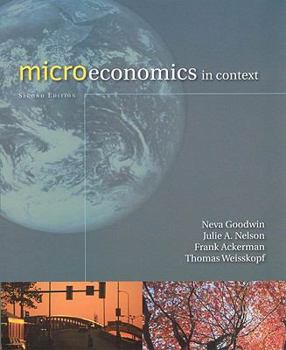Microeconomics in Context
Select Format
Select Condition 
Book Overview
Microeconomics in Context lays out the principles of microeconomics in a manner that is thorough, up to date, and relevant to students. Like its counterpart, Macroeconomics in Context, the book is... This description may be from another edition of this product.
Format:Paperback
Language:English
ISBN:0765623013
ISBN13:9780765623010
Release Date:August 2008
Publisher:Routledge
Length:522 Pages
Weight:1.95 lbs.
Dimensions:1.2" x 7.5" x 9.1"
Customer Reviews
3 ratings
mainstream econ and it's critique (from a broader perspective)
Published by Thriftbooks.com User , 17 years ago
I found a descriptive review of this book on the AdBusters-dot-org website http://adbusters.org/the_magazine/69/The_Revolution_Will_Begin_with_a_Textbook_Part_Two.html Flipping through your introductory text, you discover that it's not made up of countless variations of curves intersecting. Prose that celebrates perfectly competitive though non-existent markets seems to be in short supply. Economic heresies - "other goals may sometimes outweigh the goal of maximizing production" and "wealth itself is not well-being" - are committed left and right. After 18 years, the economics department has finally switched textbooks. While this new text still has supply and demand curves, there are also discussions about global warming and biodiversity loss. The authors draw on insights from psychology. They raise questions about overconsumption in rich countries. And they expose the mainstream circular flow model - the one that endlessly creates products without material or energy inputs, and without generating waste - as a fraudulent perpetual motion machine. You are, to say the least, a bit taken aback. Welcome to Microeconomics in Context, by Neva Goodwin and three of her colleagues, a team that has expertise in mainstream, feminist, institutional and ecological economics. Their text dives right into poverty, inequality, unemployment, the gains and costs involved in trade, the linkages between economic activity and the environment. To the trio of activities that are normally the focus of economic analysis - production, distribution and consumption - the authors add resource maintenance. It's a massive leap forward for economists to methodically look at what is needed in order to tend to, improve or preserve the natural and social resources that support economic activity and quality of life. Homo economicus still makes appearances in Goodwin's book, but mainly to help students converse in the language of neoclassical economists. Instead, the authors focus on how society can shape the economy to enable people to live healthy, meaningful lives and to live in harmony with each other and with nature. They seek to resurrect the profession's historical interest in exploring means other then economic growth for alleviating poverty and deprivation. Their economics once again focuses on well-being, rather then the artifice of utility, which allows us to replace the maximization of consumption with more complex goals. Markets still have their place, the authors concede. They communicate information about desires and scarcity amongst buyers and sellers. They create incentives and they help coordinate economic activity. But they do not correct for inequities in distribution, leaving some desperately poor while others buy a third vacation home. Markets can also favor the undemocratic exercise of power, and they can undermine the conditions required for sustainability and community. Economic policy, this text argues, must take into account these realities. Mic
Heterodox enough
Published by Thriftbooks.com User , 18 years ago
This book does exactly what the above Book Description says it does so there is no need to give a summary description here. Because this book takes a "broader" approach (which here means that it incorporates insights from non-neoclassical schools of thought and other disciplines), it necessarily gives a bit less attention to the "mechanics" of some basic neoclassical tools (viz. details about and permutations of graphical representations of models). This is not to say it doesn't deal pretty fairly with the dominant paradigm or give a clear introductory account of it. It certainly does that. It is suggested, however, that a student wishing to thoroughly understand some of the finer details of graphical representations of neoclassical models (and deductions from them) should use this book in conjunction with a "standard" introductory Microeconomics textbook, such as by Robert Frank or John Sloman. Equally, if a good student is to become a good economist, s/he would do well to read Goodwin et.al. in conjunction with their "standard" text. Thinking outside the (Edgeworth) box is more and more a prerequisite for economists these days.
Excellent
Published by Thriftbooks.com User , 18 years ago
This book does an excellent job providing an heterodox view of microeconomic theory. It provides insights from economists outside of the neoclassical model (many Nobel Prize winners), giving a more complete and realistic picture of how economics works. It is also clearly written with excellent examples and clear quantitative analysis.





